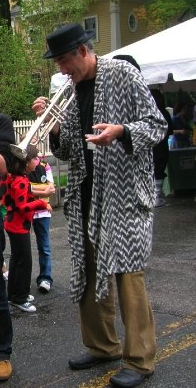The cohort of 1950s trumpet players is a pretty astonishing lot. Booker Little, one of that (often ill-fated) group, died of uremic poisoning at 23 and only recorded between 1959 and 1961. The album Out Front (released in 1961, now being reissued by Candid), is arguably the best recorded representation of his unique voice as trumpeter and composer-arranger. The lineup: Booker Little, trumpet; Eric Dolphy, alto sax; Julian Priester, trombone; Art Davis and Ron Carter, bass; Don Friedman, piano; and Max Roach, drums. All compositions are by Little.
From Memphis and schooled at the Chicago Conservatory, Little was a master technician on the trumpet. His unique tone managed to be both pleading and stentorian, copper and silver, focused but not excessively narrow. His varied use of vibrato, and of the extreme registers of the horn, together with his compositions, were the tools he used to investigate crucial, foundational aspects of jazz.
Although less bluesy/funky, there’s something of Charles Mingus in Little’s compositions, particularly in the stops and starts, along with the variations in tempo. I also hear similarities to the voicings used by Wayne Shorter in his arrangements, such as, for example, in Freddie Hubbard’s 1963 album Body and Soul. (Why so many Shorter tunes have become standards while Little’s are seldom played may be a result of the often through-composed structure of his compositions and, of course, the brevity of Little’s career).
Little was looking for a certain kind of freedom, but it was not the freedom of Ornette or of Dolphy, though they sound very natural playing side by side. Little’s idea of liberty called for more strictures. “Moods in Free Time” is a good reflection of this. The time here is not “free” in the customary sense. It derives its flexibility from a subtly crafted shifting of time signatures — from 3/4 to 4/4 to 5/4 to 6/4 meter.
The songs “Man of Words “and “Hazy Hues” are actually “program music” — a format seldom approached in jazz. The first is Little’s attempt to describe the journey of a writer confronting a blank piece of paper. Ideas are tested until a pattern emerges; at that point the real work has been accomplished. The second tune, almost a concerto for trumpet, limns a painter at work, starting with the germ of an idea and bringing it to completion.
Despite Little’s technical proficiency and knowledge of harmony, he considered technique less important than communication. Little said, “If you insist that this note or that note is wrong … you’re thinking conventionally–technically, and forgetting about emotion.…There are certain feelings that you might want to express that you could probably express better if you didn’t have that [bounding, continuous] beat. Up until now if you wanted to express a sad or moody feeling you would play the blues. But it can be done in other ways.”
Little’s oeuvre is distinctive and deserves wider attention. This reissue is an excellent place to begin to explore his very brief career. Don’t be surprised if you listen and two thoughts arise: “Why didn’t I know this music?” and ”What if…”


